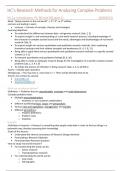Samenvatting
Summary Research Methods for Analyzing Complex Problems (RMCP) Exam 1 (DT 1)
- Vak
- (AM_1182)
- Instelling
- Vrije Universiteit Amsterdam (VU)
Extensive summary of all lectures for the first exam of RMCP (hc 1 to 6). Images are included. I got an 8.9 :)
[Meer zien]




